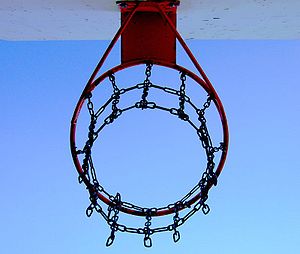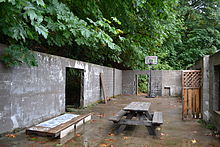- Variations of basketball
-
Variations of basketball are games or activities based on, or similar to, the game of basketball, in which the player utilizes common basketball skills. Some are essentially identical to basketball, with only minor rules changes, while others are more distant and arguably not simple variations but distinct games. Other variations include children's games, contests or activities intended to help the player practice or reinforce skills, which may or may not have a competitive aspect. Most of the variations are played in informal settings, without the presence of referees or other officials and sometimes without strict adherence to official game rules.
Contents
Rule Variations
Games under these rules are still considered to be basketball, with variant rules suited to the circumstances.
Different roster sizes
An actual competitive game of basketball can be played with as few as two people. The game may be referred to by the number of people on each team; a six-player game may be referred to as "three-on-three" or "3-v-3" ("v" stands for "versus"). Each team's roster is typically the same size, but an odd number of players may force one team to play with one less player. Sometimes the odd player will be designated as a "switch" player, so that the offensive team always has the extra player.
Roster sizes above five players per team are uncommon even in informal games, as the court generally becomes too crowded to allow movement and space to develop between players.
Six-on-six basketball was a form of basketball played in the twentieth century mainly among high school girls.
Three-on-three basketball remains competitively played by amateurs. More recently, FIBA has created a formalized version of three-on-three known as FIBA 33.
Other Games Using Basketball Skills and Equipment
Twenty-one
Main article: 21 (basketball)"Twenty-one" is a game that can be played with two or more players. Each player has their own score, with the winner being the first to reach 21 points. The game begins with one of the players "breaking", which is to shoot one free throw with the ball to determine if he or she starts the game. While all other players can attempt to stop the score, the player who missed the last shot is usually the one "responsible" for playing defense against the next offensive player. However, no player has any teammates at any time in the game. The player with the ball may shoot at any time, and may collect his own rebound and shoot again. On a defensive rebound, the rebounder takes possession and must clear the ball by dribbling it beyond the three-point line before taking a shot. Whenever a basket is scored, that player receives two points and goes to the free throw line, where each made free throw tacks on another one point to their score. The player is allowed to shoot free throws until he misses, at which point another player must rebound the ball, and the sequence starts again. This game can be played with the concept of tipped shots, where a player tips the ball in the basket off of a rebound of an opposing player's missed shot, the original shooter's score is reset back to zero, the tip can be made from anywhere on the court and only counts if the tip is made while the players feet are off the ground. Depending on if three pointer are allowed in the game a tip can be worth two or three points. The game can also be played with deductions, such as minus one point when a player air-balls a shot or commits a traveling violation. Twenty-one is nearly always played in a half court game.[1]
Spin-offs from basketball that are now separate sports include:
Korfball
Main article: KorfballKorfball started in the Netherlands and is now played worldwide. Korfball (Dutch: Korfbal) is a mixed gender team ball game, similar to mixed netball and basketball.
Netball
Main article: NetballNetball is a limited-contact team sport in which two teams of seven try to score points against one another by placing a ball through a high hoop. Netball formerly called "women's basketball" but now includes men's teams as well.
Slamball
Main article: SlamballSlamball is full-contact basketball, with trampolines. Points are scored by playing the ball through the net, as in basketball, though the point-scoring rules are modified. The main differences from the parent sport is the court; below the padded basketball rim and backboard are four trampolines set into the floor which serve to propel players to great heights for slam dunks. The rules also permit some physical contact between the members of the four-player teams.
Others
BASEketball is a fictional sport combining elements of basketball and baseball, which was the subject of a comedy film.
Activities
H-O-R-S-E
"H-O-R-S-E" redirects here. For the poker variant, see H.O.R.S.EIn H-O-R-S-E, the object is to be the last to accrue the five letters, H-O-R-S-E. H-O-R-S-E is played with two or more people.
In H-O-R-S-E, player #1 is allowed to shoot from anywhere on the court. If he makes the shot, then player #2 must duplicate the same shot from the same position. If player #2 misses, he/she receives the first "letter" from the word "horse", "H". If player #2 makes the shot, no letter is given to either player, player #2 receives control of the ball, and he/she can select a new shot from anywhere on the court.
If player #1 missed his original shot, then player #2 would also be free to shoot from anywhere on the court. In either case where player #2 selects a new shot, the play proceeds as before: if he/she makes it, it forces the next player (player #1 if there are only two players; or #3 if there are more than two players) to try and duplicate his made shots; should he/she miss, the next player has a free shot selection.
The first player to spell "horse" loses.
The game is essentially the same with three or more players, possibly with some slight tweaks to the rules. In most cases, all players must make the same shot as the first player or receive a letter, until the turn returns to the first player.
Neither player may call the type of shot that will be taken.
In some variations, control of the ball will cycle indefinitely until one player gets a letter. In this case, the person who made the original shot could wind up with a letter, if he or she is the first one to miss.
Other variations and rule-changes include:
1. O-U-T, B-O-B or P-I-G, are faster versions of H-O-R-S-E. D-O-N-K-E-Y is another variation of H-O-R-S-E, with another letter, making this version last a little longer. D-I-R-T, or G-R-A-S-S are also common variations of the game.
2. Players may not repeat a "made" shot. Once a shot has been made in one place or style, it cannot be taken again.
3. Proving the Shot: After someone gets H-O-R-S-E, the person who originally made the shot (Player1) must make the shot again from the same spot to prove that the shot was skill and not luck. If he makes it, the other player (Player2) is out, but if he misses, the other player stays in. Player2 STILL retains the last letter earned (in this case, "E") and may take the next shot and play continues as normal. If Player1 makes another successful shot, then Player1 must immediately take a 2nd shot to oust Player2.
4. Insurance Shot: Taken when a player reaches the last letter. If made, it allows the player to stay in the game with one letter less than the maximum.
5. Tipping, or "tip-horse": The player whose turn is immediately after the shooter may tip the ball back into the basket on a miss, giving the shooter an extra letter.
6. Airball: A player may be given a letter for shooting an "airball", a shot that misses and does not hit either the backboard or the rim.
Around the World
Around the World (sometimes Around the Key) is a basketball variant played by two or more players, who have all agreed upon a turn order. The game requires a sequence of shooting positions to be decided upon. In theory, these positions are arbitrary; in practice, they are most commonly ordered along the 3-point line in equal intervals starting from one of the sides of the basket and including the straight-on center shot (e.g., 0, 30, 60, 90, 120, 150, and 180 degrees along the 3-point line with 90 being the center). This 180-degree semi-circular path is the inspiration for the game's name. The object is to be the first player to make a shot from all positions. Making a shot from a position allows a player to advance to the next position. The rules are very flexible but usually a player keeps advancing until a missed shot. The consequences of missing a shot may vary. Sometimes the game is played such that a missed shot requires the player to start over at the first position. Under this rule, the game may also include another rule that allows a player to "save" their position, and pass the ball to the next player. It is probably most common, however, to play such that each player continues until a missed shot. At this point a player may save his position or elect to take another "chance" shot. If the chance shot is made, the player advances as normal. If it misses, the player's turn ends and they suffer some penalty, perhaps regressing a position or even starting over. Whatever the specifics of the game, when a player makes a successful shot from the final position, the game enters the final stage. Some play such that this player is declared the winner. Other play such that those players who have yet to act on the turn get a chance to tie, which cancels any advantage of going first.
There are a multitude of ways the game can be modified. Other variations include: shooting with the off arm, shooting with alternating arms, using the backboard on every shot (except those directly to the side of the basket), or having positions around the key or even under the basket.[2][3]
References
Basketball History and General History of basketball · James Naismith · Variations of basketball · Glossary of terms · Outline · Index of articles

Rules Officials · 3 seconds · 5 seconds · Carrying · Double dribble · Foul · Goaltending · Traveling · Basket interference · Jump ball
Game play Positions · Layup · Slam dunk · Jump shot · Free throw · Three-pointer · Moves · Rebound · Assist · Dribble · Block · Screen · Flop · Cherry picking
Equipment Ball · Court · Key (lane) · Backboard · Breakaway rim · Shot clock
Clothing Basketball sleeve · Finger sleeve
Categories:- Forms of basketball
Wikimedia Foundation. 2010.


